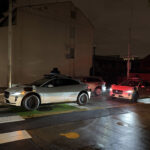Several young adults from West Virginia are starring in a new educational film on the dangers of distracted driving that is to be released this spring.
Charleston, West Virginia-based MotionMasters is producing the film, “Deadly Driving Distractions,” for Films Media Group, based in Hamilton, N.J. Once completed, the film will be distributed to high schools, drivers education programs and communities throughout the nation
In one scene, Laura Pugh, 19, keeps her phone on her lap as she drives her Nissan Pathfinder, ready to respond to any text or call.
So does Melanie Perry. Perry, also 19, flips through songs on her iPod as she travels. She admits she sometimes has to stop abruptly to prevent an accident once her eyes return to the road.
P.K. Khoury, a copywriter at MotionMasters, said the film is designed to educate and inform teens of the dangers of distracted driving, to draw their attention to the cautionary messages, to persuade them to pass along the information and to influence behavior among their peers.
MotionMasters began the project this past November and its expected release date is late spring. Diana Sole Walko, executive producer and owner of MotionMasters, is directing the film.
Seven West Virginia high school and college-aged students gathered last week at 222 Capitol St. to discuss their experiences of driving while distracted.
George Manahan, owner of The Manahan Group, opened his office’s doors to the filming crew for the evening. The office’s dramatic interior qualities were perfect for the film, Khoury said.
“They have a beautiful building with exposed brick,” she said. “It has a very coffee-house look; it feels like a New York loft.”
Annually, 80 percent of approximately 6,000 fatalities and more than 500,000 injuries sustained in vehicle accidents are caused by distracted driving, according to the National Highway Traffic Safety Administration.
Developments in hand-held technology – such as portable music players and cell phones – have increased the number of driving distractions that teens have to deal with.
Now not only are food, drink, billboards, passengers and weather conditions common distractions, but technology can also cause drivers to take their eyes of the road, hands off the wheel and mind off the road, according to the Federal Highway Administration.
“We’re interested in awareness and behavioral change in the target audience,” said Khoury. “Texting behind the wheel is a much bigger problem than people understand.”
Khoury learned firsthand how many young adults use their phones while driving, when conducting a focus group at George Washington High School. She said all of the students in the focus group admitted they have sent text messages while driving.
“I was pleased that they were candid, but very concerned for the safety of everyone,” Khoury said. “These are digital natives. They have grown up with people on mobile devices 24/7. It does not seem incongruent to them to take phone calls, return phone calls, receive texts and send texts all the time even while driving.”
Motion Masters has been in the educational film business for 20 years. This project poses an interesting challenge to videographers, photographers, directors and editors.
“It has to be in the language of the target audience, and it has to be an open and free discussion,” Khoury said.
The film is designed to speak to teens, with edgy graphics and effects. The film will prominently feature generational and cultural icons, such as Facebook, Twitter, skateboards, computers, backpacks, iPhones, iPods, to send a message to the specific age group.
“Research indicates that teenagers respond best to peer group messages,” Khoury said. “No one likes to be lectured to or told that their behavior is unsatisfactory; any age dismisses that immediately.
“In order to convey information, it has to be in the vernacular of the target age group.”
Khoury said “immediacy is everything” with teens and young adults.
Nicole Mata, 21, agrees. She said she is somewhat dependent on her cell phone.
“You feel kind of empty without it,” Mata said. “It’s kind of like a necessity, a need; like you can’t wait to respond to a text.”
When asked how quickly she responds after getting a text while driving, Mata replied, “It depends on how fast I can find my phone.”
She has had a couple of wake-up calls driving off the road, over rumble strips on the side of the interstate.
“It scared me, but I just continued to text,” Mata said.
Mata and her boyfriend, John Williams, were interviewed together because the couple often rides together.
Filmmakers asked students: How often are you on the phone while driving? Do you ride with other teen drivers? Have you ever had an accident? Do you ride with people who text while driving? Do you text while driving?
Mata said she and Williams, 20, are a distraction to one another.
“Sometimes when we’re talking in the car to each other, we’ll look at each other,” Mata admits.
Williams, a communication and film major at West Virginia State University, said passengers are his biggest distraction.
“If somebody is looking for something in the backseat, or they ask me to change the music, it’s distracting,” Williams said.
Pugh has also been the victim of distracted driving.
“In high school I always had a lot of people riding in my car,” said the Capital High School graduate. “I couldn’t see out the back window and it was so loud.”
The film strives to bring awareness and change behaviors of both the driver and the passengers.
“We think that this treatment will empower teen passengers to say to drivers, ‘Don’t text while you’re driving,’ or, ‘Let me have your phone, I’ll take your calls,’ ” Khoury said.
Zakia Syifa, 18, is an exchange student studying from Indonesia at South Charleston High School. While the senior does not drive in this country, in Indonesia she is the proud driver of a motorcycle.
Due to chaotic traffic patterns in her home country, Syifa said texting while driving is almost out of the question.
“People obey traffic regulations here,” Syifa said. “But in my country it’s so crowded and dangerous that you really have to watch the road.”
Syifa said she does answer phone calls while riding her motorcycle, though on a hands-free, headset.
Khoury said even hands-free devices cause distraction.
Perry, a freshman at University of Charleston, pointed out that her father also fiddles with his phone while driving.
“He gets like 300 e-mails a day, so he’s always on his phone in the car,” Perry said.
Khoury hopes that teens also take their new knowledge to their parents, who may be the teachers of the bad behaviors.
“That’s not a bad result, either,” Khoury said. “The safer, the better; I don’t think anyone can argue that.”
Most of the teens stated that they hope their involvement with the film helps them remember to change their own behaviors.
“It hope it makes me aware of my actions and the impact that they can have,” Mata said.
Topics Auto Personal Auto Virginia Education
Was this article valuable?
Here are more articles you may enjoy.


 Court Ruling Could Help Shed Light on Owners of Litigation Funders, Medical Clinics
Court Ruling Could Help Shed Light on Owners of Litigation Funders, Medical Clinics  Viewpoint: Artificial Intelligence Is Rewriting the Rules for Commercial Lines
Viewpoint: Artificial Intelligence Is Rewriting the Rules for Commercial Lines  Waymos Froze, Blocked Traffic During San Francisco Power Outage
Waymos Froze, Blocked Traffic During San Francisco Power Outage  Three Top P/C Insurers Account for Most of Insurance AI Patents
Three Top P/C Insurers Account for Most of Insurance AI Patents 

